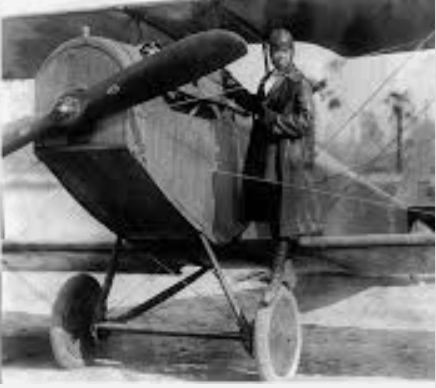Bessie Coleman was one of the early pioneers of flight. Called “Brave Bessie” and “Queen Bessie,” she reveled in performing daring stunts for startled crowds. She dazzled audiences in spite of two drawbacks: Bessie Coleman was a woman, and she was African American.
Coleman was one of twelve children, who picked cotton in Texas and saved her money to go to university. She couldn’t afford more than one semester, so she moved to Chicago to live near her brothers. After attending Burnham School of Beauty Culture in 1915, she was employed as a manicurist in a barbershop.
Her brothers fought in World War I and returned home with stories of French women flying airplanes. Entranced by the possibility, she applied to flight schools but her race and gender resulted in repeated rejections. Determined, she studied French then enrolled in a French aviation school, earning her pilot’s license in 1921. Coleman graduated from the Fédération Aéronautique Internationale, becoming the first black person in the world to earn an international pilot’s license.
In order to earn money for her own plane, Coleman performed dangerous tricks for audiences, including circle 8 loop-the-loops and wing-walking. She gave flight lessons and spoke publicly, but only where there was no discrimination against people of color.
In 1925 she bought her own plane, a Jenny, and returned to her hometown in Texas to perform. When she learned there were two separate entrances for blacks and whites, she refused to proceed with her exhibition. After negotiations, those running the venue agreed to have one entrance, if the seating would be segregated. Coleman compromised and performed.

In 1926, when Coleman was only 34 years old, she flew a practice flight for an air show with pilot William Wills. She was seated in the back seat of the Jenny when a loose wrench entered the engine. Willis lost control as the plan flipped over. Coleman was not wearing a seatbelt and fell from the airplane at 3,500. She had crashed three years before, breaking a leg and several ribs, and recovered, but this time the accident was fatal.
Although her name is not noted often in history books, her memory has been kept alive. In 1931, the Challenger Air Pilots’ Association of Chicago was organized and built an airstrip for blacks in Robbins, Illinois. They also began the tradition of flying over Coleman’s grave every year. African American women pilots organized in 1977, forming the Bessie Coleman Aviators Club. In 1995, Coleman was honored with a U.S. stamp. And at the end of last year, on December 11, 2019, the New York Times published an extensive obituary for her, one of their series of “Overlooked No More” obituaries for the minorities and women who have been ignored during their more than a century and a half of publication. Queen Bessie is surely laughing and doing barrel rolls in the sky.

